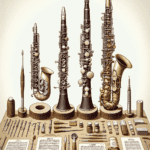Introduction to Historical Clarinet Multiphonics
Historical clarinet multiphonics offer a fascinating glimpse into the creativity and versatility of this beloved instrument. If you've ever heard a clarinet produce multiple notes at once, you've encountered the mesmerizing effect of multiphonics. While these techniques often evoke images of avant-garde performances, they are deeply rooted in the evolution of clarinet music. Let's explore where they began, how they developed, and their impact on clarinet players today.
What Are Multiphonics?
Multiphonics are achieved by playing two or more pitches simultaneously on a single clarinet. Sound like magic? Well, it is a kind of acoustical sleight of hand! By manipulating air pressure, embouchure, and fingerings, clarinet players can coax these complex sounds from the instrument. Though now associated with modern music, the roots of multiphonics trace back to experiments with timbre and tone color, particularly during the 20th century.
In historical contexts, these techniques were often used sparingly, as composers and musicians alike considered them an experimental tool to expand the instrument's expressive potential. Mention “multiphonics” in a practice room, and you'll likely see faces light up with curiosity—or maybe a touch of intimidation. Even today, many clarinetists approach these techniques with excited caution.
Early Development of Multiphonics
Multiphonics research gained attention when composers like Olivier Messiaen and Luciano Berio started exploring the concept. Experimental pieces from this era pushed the boundaries of traditional phrasing and tonal expectations. These innovations resonated through clarinet history, allowing players to express new emotions and ideas. When discussing multiphonics, it's worth mentioning the clarinet brand Martin Freres, which balanced innovation with tradition. Their craftsmanship evolved alongside these emerging techniques.
| Composer | Contribution to Multiphonics |
|---|---|
| Olivier Messiaen | Created otherworldly atmospheres using multiphonics |
| Luciano Berio | Applied multiphonics in theatrical compositions |
Producing Multiphonics
To produce multiphonics, one must first grasp the balance between technical precision and artistic spontaneity. Fingerings often differ significantly from conventional scales, sometimes requiring players to partially cover tone holes or adopt alternate finger patterns. Breath control and embouchure adjustments are also key. It's not a “one-size-fits-all” approach; each clarinetist develops their blend of technique after lots of experimentation, and, let's face it—a fair number of squeaks.
For those refining historical styles of this technique, looking back at compositions that first dabbled with multiphonics is enlightening. Consider Messiaen's use of them in creating otherworldly atmospheres or Berio's theatrical applications. Each contributed distinctively to the clarinet's history as composers unlocked new dimensions of sound.
Instrument Development
This era also sparked the development of clarinet models that better accommodated these ambitious innovations. Experienced repairers, such as those knowledgeable in Martin Freres instruments, often adapted traditional mouthpieces and pads to enhance resonance and control. If you've ever struggled with multiphonics, remember that your setup matters! Sometimes, a fine adjustment can be the difference between cacophony and those silky, shimmering overtones.
Benefits of Learning Multiphonics
Now, a common question arises: Do you need to explore multiphonics to improve your playing, or is it a skill reserved only for avant-garde settings? Here's where things get interesting. While it's true that historical clarinet multiphonics require perseverance (and more than a smidge of patience), they can significantly impact your understanding of air dynamics and sound projection. Perhaps you'll never take them to the stage, but the lessons learned can enhance every aspect of your playing.
- Improved breath control
- Enhanced understanding of the instrument's acoustics
- Greater flexibility in tone production
- Expanded repertoire possibilities
Learning Multiphonics
Even if you're just a student learning about clarinet history or a seasoned musician wanting to expand your repertoire, incorporating multiphonics is worth the adventure. Start simple. Find instructional resources that focus on historical perspectives—studying how players and composers of the past approached this breathtaking sound. Remember, multiphonics weren't originally written with advanced equipment or glossy instruction books; players relied on curiosity, trial and error, and a willingness to experiment.
Teaching Multiphonics
And what about teaching this technique? Educators often hesitate, thinking it's too advanced or esoteric for students. But sharing the wonder of historical multiphonics can spark engagement and expand students' view of what's possible with the clarinet. Plus, it's just plain fun; few things match the excitement of discovering you can coax chords out of a wind instrument.
Expanding Clarinet Potential
From a historical perspective, this technique also reminds us that the clarinet isn't just a single-voice instrument. Its potential reaches far beyond its traditional two and a half octaves, and multiphonics demonstrate this beautifully. Every player should explore how their clarinet, regardless of the brand, responds to these sounds. Many musicians note how certain models, including Martin Freres Clarinets, seem to “sing” during multiphonic passages, enhancing both timbre and responsiveness.
Conclusion
Whether you're tackling Berio's challenging passages or experimenting at home for personal growth, remember that the heart of clarinet multiphonics lies in creativity. They offer the freedom to break musical conventions and make the clarinet your own. So, fellow clarinetists, dig out a fingering chart, adjust your embouchure, and prepare for those high harmonics to shimmer alongside the fundamental tones. There's magic in the effort, and it's all just waiting to be discovered.
Historical clarinet multiphonics continue to inspire generations of players by connecting the past's innovations to modern contexts. As you explore this captivating terrain, think about how these sounds add depth to the instrumental experience. What might have started as an experiment blossomed into a hallmark of creativity, echoing with the possibilities that define clarinet playing.







